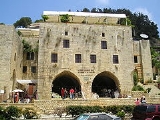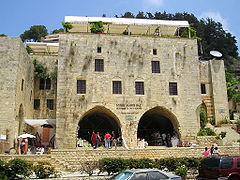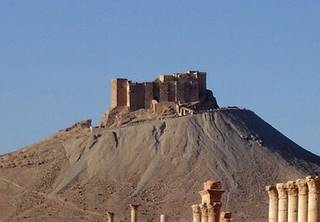
Fakhr-al-Din II
Encyclopedia
Emir Fakhr-al-Din ibn Maan (1572–April 13, 1635) was the 1st prince of the State of Lebanon which has self-governed under the Ottoman Empire between the 17th and 19th centuries. Son of Prince Qorqmaz ibn Maan and Sit Nasab of the Tanukhi family, he was given the title "Emir" or Prince in Arabic because the Maan dynasty reigned over Lebanon. His period was characterized by economic and cultural prosperity, and he had fought other Lebanese families to unite the people of Lebanon and seek independence from the Ottoman Empire. He is therefore considered by many to be the first "Man of Lebanon" to seek the sovereignty of modern-day Lebanon. However, the Ottomans had discovered his plot and executed him with three of his children on April 13, 1635.
 Born in Baakline to a Druze
Born in Baakline to a Druze
family, he was raised by Sheikh
Ibrahim Abou Sakr, a prominent Maronite from the Khazen
family, in the Lebanese village of Ballouneh
.
In 1608 Fakhr-al-Din forged an alliance with the Italian
Grand Duchy of Tuscany
. The alliance contained both a public economic section and a secret military one.
Fakhr-al-Din's popularity alarmed the Ottomans who authorized Hafiz Ahmed Pasha, Muhafiz of Damascus
, to mount an attack on Lebanon in 1613 in order to reduce Fakhr-al-Din's growing power.
Faced with Hafiz's army of 50,000 men, Fakhr-al-Din chose exile in Tuscany
, leaving affairs in the hands of his brother Emir Yunis and his son Emir Ali Beg. Fakhr-al-Din's exile did not prompt the Lebanese army to surrender to Hafiz Ahmed Pasha's army. They maintained their positions while the military operations raged until Emir Yunus managed through negotiations and persuasion to bring an end to the killings, securing the retreat of the Ottoman army.
Hosted in Tuscany by the Medici Family, Fakhr-al-Din was welcomed by the grand duke Cosimo II, who housed him throughout his stay. Fakhr-al-Din had wished to enlist Tuscan assistance in the liberation of Lebanon, but was met with a refusal as Tuscany was unable to afford such an expedition. The prince soon gave up the idea, eventually realizing that such cooperation would only subject Lebanon to a new occupation. His stay nevertheless allowed him to witness Europe's cultural revival in the 17th century.
In 1618, political changes in the Ottoman sultanate had resulted in the removal of many of Fakhr-al-Din's enemies from power, signaling the prince's triumphant return to Lebanon soon after, upon which he was able quickly to reunite all the lands of Lebanon beyond the boundaries of its mountains; and having revenge from Emir Yusuf Pasha ibn Siyfa, attacking his stronghold in Akkar, destroying his palaces and taking control of his lands, and regaining the territories he had to give up in 1613 in Sidon, Tripoli, Bekaa among others. Under his rule, printing press
es were introduced and Jesuit priests and Catholic nuns encouraged to open schools throughout the land.
 In 1623, the prince was betrayed by the Harfouch family who made arrangements with Mustafa Pasha, Mirmiran of Damascus, to launch an attack against him, resulting in the battle at Majdel Anjar where Fakhr-al-Din's forces although outnumbered managed to capture Pacha and secure the Lebanese prince and his allies a much needed military victory,and he took over Syria and Palestine from the Turks.
In 1623, the prince was betrayed by the Harfouch family who made arrangements with Mustafa Pasha, Mirmiran of Damascus, to launch an attack against him, resulting in the battle at Majdel Anjar where Fakhr-al-Din's forces although outnumbered managed to capture Pacha and secure the Lebanese prince and his allies a much needed military victory,and he took over Syria and Palestine from the Turks.
However, as time passed, the Ottomans seemed uncomfortable with the prince's increasing powers and extended relations with Europe
. The promise they had made to the Medici family, regarding the Prince of Lebanon, was ignored. In 1632, Kuchuk Ahmed Pasha was named Muhafiz of Damascus, being a rival of Fakhr-al-Din and a friend of Sultan Murad IV
, who ordered Kuchuk Ahmed Pasha and the sultanate's navy to attack Lebanon and depose Fakhr-al-Din.
This time, the prince had decided to remain in Lebanon and resist the offensive, but the death of his son Emir Ali Beik in Wadi el-Taym was the beginning of his defeat. He later took refuge in Jezzine
's grotto, closely followed by Kuchuk Ahmed Pasha who caught eventually with him and his family.
Fakhr-al-Din was taken to Istanbul and appeared before the sultan.
Later, the sultan had Fakhr-al-Din and his family killed on 13 April 1635, in Constantinople
, bringing an end to possibly one of the greatest eras in the history of Lebanon.
After his Death ,his Children and grand Children continued ruling Lebanon under the name of State of Lebanon until 1842 when the first Lebanese Civil War started between the Druze and Christians and dividing it to two states by the Turks.
Rumors have it that Fakhr-al-Din had secretly adopted the Christian faith. Those rumours, later proven to be baseless, were encouraged by the Christian regents that followed the Maans to try to appease the powerful Druze clans.
Biography

Druze
The Druze are an esoteric, monotheistic religious community, found primarily in Syria, Lebanon, Israel, and Jordan, which emerged during the 11th century from Ismailism. The Druze have an eclectic set of beliefs that incorporate several elements from Abrahamic religions, Gnosticism, Neoplatonism...
family, he was raised by Sheikh
Sheikh
Not to be confused with sikhSheikh — also spelled Sheik or Shaikh, or transliterated as Shaykh — is an honorific in the Arabic language that literally means "elder" and carries the meaning "leader and/or governor"...
Ibrahim Abou Sakr, a prominent Maronite from the Khazen
Khazen
Khazen is the name of a prominent Noble Levantine family based in Keserwan District, Lebanon, Damascus, Syria, Nablus, Palestine as well as other distrits around the Levant. The Khazen family have traced their lineage through DNA testing to Jericho, Palestine also known as Tell el-Sultan 8500 B.C....
family, in the Lebanese village of Ballouneh
Ballouneh
Ballouneh is a small town neighboring Ajaltoun and located in the Keserwan District of the Mount Lebanon Governorate. It has an approximate area of 1400 m2 and an altitude of 700-800 m above sea level.- Etymology :...
.
In 1608 Fakhr-al-Din forged an alliance with the Italian
Italy
Italy , officially the Italian Republic languages]] under the European Charter for Regional or Minority Languages. In each of these, Italy's official name is as follows:;;;;;;;;), is a unitary parliamentary republic in South-Central Europe. To the north it borders France, Switzerland, Austria and...
Grand Duchy of Tuscany
Grand Duchy of Tuscany
The Grand Duchy of Tuscany was a central Italian monarchy that existed, with interruptions, from 1569 to 1859, replacing the Duchy of Florence. The grand duchy's capital was Florence...
. The alliance contained both a public economic section and a secret military one.
Fakhr-al-Din's popularity alarmed the Ottomans who authorized Hafiz Ahmed Pasha, Muhafiz of Damascus
Damascus
Damascus , commonly known in Syria as Al Sham , and as the City of Jasmine , is the capital and the second largest city of Syria after Aleppo, both are part of the country's 14 governorates. In addition to being one of the oldest continuously inhabited cities in the world, Damascus is a major...
, to mount an attack on Lebanon in 1613 in order to reduce Fakhr-al-Din's growing power.
Faced with Hafiz's army of 50,000 men, Fakhr-al-Din chose exile in Tuscany
Tuscany
Tuscany is a region in Italy. It has an area of about 23,000 square kilometres and a population of about 3.75 million inhabitants. The regional capital is Florence ....
, leaving affairs in the hands of his brother Emir Yunis and his son Emir Ali Beg. Fakhr-al-Din's exile did not prompt the Lebanese army to surrender to Hafiz Ahmed Pasha's army. They maintained their positions while the military operations raged until Emir Yunus managed through negotiations and persuasion to bring an end to the killings, securing the retreat of the Ottoman army.
Hosted in Tuscany by the Medici Family, Fakhr-al-Din was welcomed by the grand duke Cosimo II, who housed him throughout his stay. Fakhr-al-Din had wished to enlist Tuscan assistance in the liberation of Lebanon, but was met with a refusal as Tuscany was unable to afford such an expedition. The prince soon gave up the idea, eventually realizing that such cooperation would only subject Lebanon to a new occupation. His stay nevertheless allowed him to witness Europe's cultural revival in the 17th century.
In 1618, political changes in the Ottoman sultanate had resulted in the removal of many of Fakhr-al-Din's enemies from power, signaling the prince's triumphant return to Lebanon soon after, upon which he was able quickly to reunite all the lands of Lebanon beyond the boundaries of its mountains; and having revenge from Emir Yusuf Pasha ibn Siyfa, attacking his stronghold in Akkar, destroying his palaces and taking control of his lands, and regaining the territories he had to give up in 1613 in Sidon, Tripoli, Bekaa among others. Under his rule, printing press
Printing press
A printing press is a device for applying pressure to an inked surface resting upon a print medium , thereby transferring the ink...
es were introduced and Jesuit priests and Catholic nuns encouraged to open schools throughout the land.

However, as time passed, the Ottomans seemed uncomfortable with the prince's increasing powers and extended relations with Europe
Europe
Europe is, by convention, one of the world's seven continents. Comprising the westernmost peninsula of Eurasia, Europe is generally 'divided' from Asia to its east by the watershed divides of the Ural and Caucasus Mountains, the Ural River, the Caspian and Black Seas, and the waterways connecting...
. The promise they had made to the Medici family, regarding the Prince of Lebanon, was ignored. In 1632, Kuchuk Ahmed Pasha was named Muhafiz of Damascus, being a rival of Fakhr-al-Din and a friend of Sultan Murad IV
Murad IV
Murad IV Ghazi was the Sultan of the Ottoman Empire from 1623 to 1640, known both for restoring the authority of the state and for the brutality of his methods...
, who ordered Kuchuk Ahmed Pasha and the sultanate's navy to attack Lebanon and depose Fakhr-al-Din.
This time, the prince had decided to remain in Lebanon and resist the offensive, but the death of his son Emir Ali Beik in Wadi el-Taym was the beginning of his defeat. He later took refuge in Jezzine
Jezzine
Jezzine is a town in Lebanon, located from Sidon and south of Beirut. Surrounded by mountain peaks, pine forests, and at an average altitude of 950 m , it is the main summer resort and tourist destination of South Lebanon...
's grotto, closely followed by Kuchuk Ahmed Pasha who caught eventually with him and his family.
Fakhr-al-Din was taken to Istanbul and appeared before the sultan.
Later, the sultan had Fakhr-al-Din and his family killed on 13 April 1635, in Constantinople
Istanbul
Istanbul , historically known as Byzantium and Constantinople , is the largest city of Turkey. Istanbul metropolitan province had 13.26 million people living in it as of December, 2010, which is 18% of Turkey's population and the 3rd largest metropolitan area in Europe after London and...
, bringing an end to possibly one of the greatest eras in the history of Lebanon.
After his Death ,his Children and grand Children continued ruling Lebanon under the name of State of Lebanon until 1842 when the first Lebanese Civil War started between the Druze and Christians and dividing it to two states by the Turks.
Rumors have it that Fakhr-al-Din had secretly adopted the Christian faith. Those rumours, later proven to be baseless, were encouraged by the Christian regents that followed the Maans to try to appease the powerful Druze clans.

